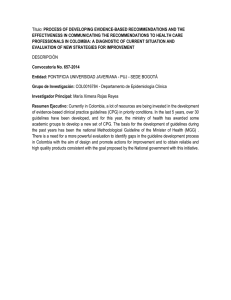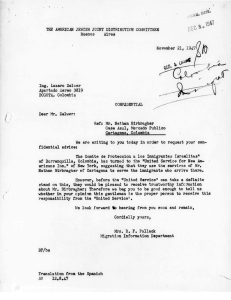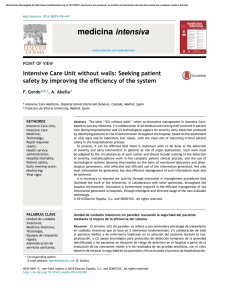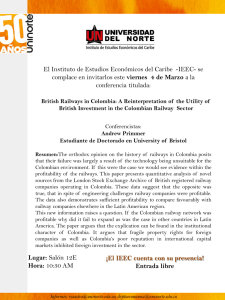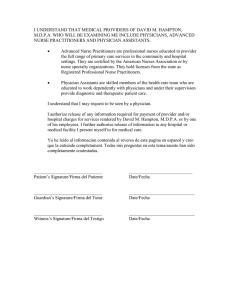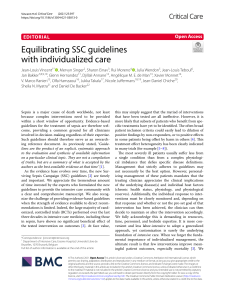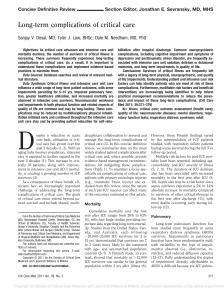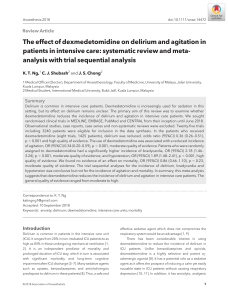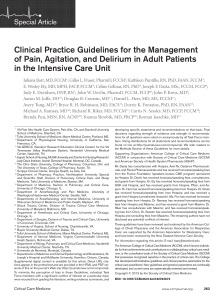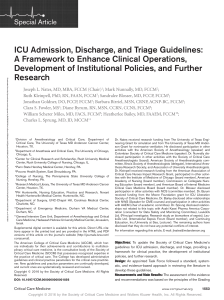Journal of Perioperative and Critical Intensive Care Nursing
Anuncio
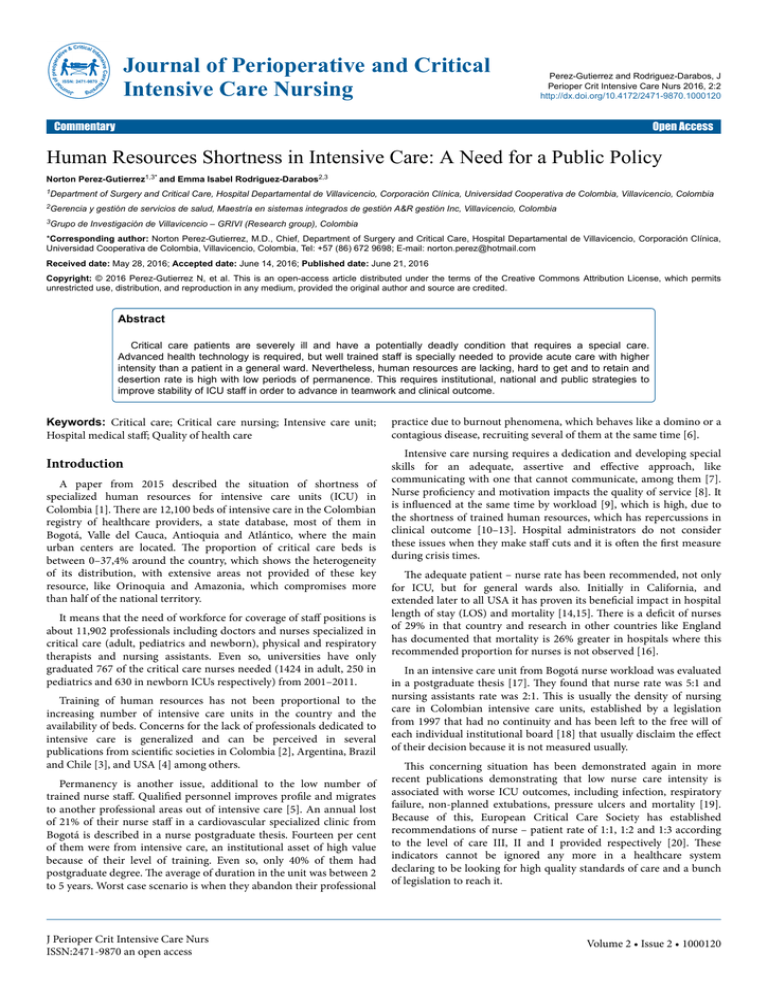
Journal of Perioperative and Critical Intensive Care Nursing Perez-Gutierrez and Rodriguez-Darabos, J Perioper Crit Intensive Care Nurs 2016, 2:2 http://dx.doi.org/10.4172/2471-9870.1000120 Commentary Open Access Human Resources Shortness in Intensive Care: A Need for a Public Policy Norton Perez-Gutierrez1,3* and Emma Isabel Rodriguez-Darabos2,3 1Department 2Gerencia 3Grupo of Surgery and Critical Care, Hospital Departamental de Villavicencio, Corporación Clínica, Universidad Cooperativa de Colombia, Villavicencio, Colombia y gestión de servicios de salud, Maestría en sistemas integrados de gestión A&R gestión Inc, Villavicencio, Colombia de Investigación de Villavicencio – GRIVI (Research group), Colombia *Corresponding author: Norton Perez-Gutierrez, M.D., Chief, Department of Surgery and Critical Care, Hospital Departamental de Villavicencio, Corporación Clínica, Universidad Cooperativa de Colombia, Villavicencio, Colombia, Tel: +57 (86) 672 9698; E-mail: norton.perez@hotmail.com Received date: May 28, 2016; Accepted date: June 14, 2016; Published date: June 21, 2016 Copyright: © 2016 Perez-Gutierrez N, et al. This is an open-access article distributed under the terms of the Creative Commons Attribution License, which permits unrestricted use, distribution, and reproduction in any medium, provided the original author and source are credited. Abstract Critical care patients are severely ill and have a potentially deadly condition that requires a special care. Advanced health technology is required, but well trained staff is specially needed to provide acute care with higher intensity than a patient in a general ward. Nevertheless, human resources are lacking, hard to get and to retain and desertion rate is high with low periods of permanence. This requires institutional, national and public strategies to improve stability of ICU staff in order to advance in teamwork and clinical outcome. Keywords: Critical care; Critical care nursing; Intensive care unit; Hospital medical staff; Quality of health care Introduction A paper from 2015 described the situation of shortness of specialized human resources for intensive care units (ICU) in Colombia [1]. There are 12,100 beds of intensive care in the Colombian registry of healthcare providers, a state database, most of them in Bogotá, Valle del Cauca, Antioquia and Atlántico, where the main urban centers are located. The proportion of critical care beds is between 0–37,4% around the country, which shows the heterogeneity of its distribution, with extensive areas not provided of these key resource, like Orinoquia and Amazonia, which compromises more than half of the national territory. It means that the need of workforce for coverage of staff positions is about 11,902 professionals including doctors and nurses specialized in critical care (adult, pediatrics and newborn), physical and respiratory therapists and nursing assistants. Even so, universities have only graduated 767 of the critical care nurses needed (1424 in adult, 250 in pediatrics and 630 in newborn ICUs respectively) from 2001–2011. Training of human resources has not been proportional to the increasing number of intensive care units in the country and the availability of beds. Concerns for the lack of professionals dedicated to intensive care is generalized and can be perceived in several publications from scientific societies in Colombia [2], Argentina, Brazil and Chile [3], and USA [4] among others. Permanency is another issue, additional to the low number of trained nurse staff. Qualified personnel improves profile and migrates to another professional areas out of intensive care [5]. An annual lost of 21% of their nurse staff in a cardiovascular specialized clinic from Bogotá is described in a nurse postgraduate thesis. Fourteen per cent of them were from intensive care, an institutional asset of high value because of their level of training. Even so, only 40% of them had postgraduate degree. The average of duration in the unit was between 2 to 5 years. Worst case scenario is when they abandon their professional J Perioper Crit Intensive Care Nurs ISSN:2471-9870 an open access practice due to burnout phenomena, which behaves like a domino or a contagious disease, recruiting several of them at the same time [6]. Intensive care nursing requires a dedication and developing special skills for an adequate, assertive and effective approach, like communicating with one that cannot communicate, among them [7]. Nurse proficiency and motivation impacts the quality of service [8]. It is influenced at the same time by workload [9], which is high, due to the shortness of trained human resources, which has repercussions in clinical outcome [10–13]. Hospital administrators do not consider these issues when they make staff cuts and it is often the first measure during crisis times. The adequate patient – nurse rate has been recommended, not only for ICU, but for general wards also. Initially in California, and extended later to all USA it has proven its beneficial impact in hospital length of stay (LOS) and mortality [14,15]. There is a deficit of nurses of 29% in that country and research in other countries like England has documented that mortality is 26% greater in hospitals where this recommended proportion for nurses is not observed [16]. In an intensive care unit from Bogotá nurse workload was evaluated in a postgraduate thesis [17]. They found that nurse rate was 5:1 and nursing assistants rate was 2:1. This is usually the density of nursing care in Colombian intensive care units, established by a legislation from 1997 that had no continuity and has been left to the free will of each individual institutional board [18] that usually disclaim the effect of their decision because it is not measured usually. This concerning situation has been demonstrated again in more recent publications demonstrating that low nurse care intensity is associated with worse ICU outcomes, including infection, respiratory failure, non-planned extubations, pressure ulcers and mortality [19]. Because of this, European Critical Care Society has established recommendations of nurse – patient rate of 1:1, 1:2 and 1:3 according to the level of care III, II and I provided respectively [20]. These indicators cannot be ignored any more in a healthcare system declaring to be looking for high quality standards of care and a bunch of legislation to reach it. Volume 2 • Issue 2 • 1000120 Citation: Perez-Gutierrez N, Rodriguez-Darabos EI (2016) Human Resources Shortness in Intensive Care: A Need for a Public Policy. J Perioper Crit Intensive Care Nurs 2: 120. doi:10.4172/2471-9870.1000120 Page 2 of 2 Some scientific societies propose government solutions in immigration and education policies to solve the crisis [4]. This might generate a switch of qualified staff between countries towards those with better opportunities, but increasing shortage in others. In conclusion, all aspects are important to provide a good care in intensive care units, organizational and technological, but human resources and teamwork is key. As written in an editorial of the American journal of intensive care: “It is not the song, not even the singers, but the way that singers sing” [21]. This should promote a public policy of better institutional incentives for engaging and longterm retention of their nurse staff. 10. 11. 12. 13. References 1. 2. 3. 4. 5. 6. 7. 8. 9. Pérez Gutiérrez N, Rodríguez Darabos EI (2015) Talento humano en unidades de cuidado intensivo: adaptación de un modelo de estándares para Colombia basado en la evidencia científica. Acta Colomb Cuid Intens 15: 80–102. Segura O, Leal R (2014) Especialidad o subespecialidad: un dilema para la unidad de cuidado intensivo en Colombia. Acta Colomb Cuid Intens 14: 247–249. Estenssoro E, Barbas CS, Román LS (2010) ICU staffing: the South American perspective. Am J Respir Crit Care Med 182: 441-442. Ewart GW, Marcus L, Gaba MM, Bradner RH, Medina JL, et al. (2004) The critical care medicine crisis: A call for federal action: A white paper from the critical care professional societies. Chest 125: 1518–1521. Pachon Cuitiva CF (2014) Diseño de un plan de carrera para los profesionales de enfermería en la unidad de cuidado intensivo de la Clínica Shaio. Universidad de la Sabana. Bakker AB, Le Blanc PM, Schaufeli WB (2005) Burnout contagion among intensive care nurses. J Adv Nurs 51: 276-287. Beltran-Salazar OA (2008) La práctica de enfermería en cuidado intensivo. Aquichan 8: 50–63. Ramirez Perdomo CA, Perdomo Romero AY, Galan Gonzalez EF (2013) Evaluacion de la calidad del cuidado de enfermeria en la unidad de cuidados intensivos. Av Enferm XXXI: 42–51. Romero-Massa E, Lorduy-Bolivar JP, Pajaro-Melgar C, Perez-Duque CA (2011) Relacion entre la carga laboral de enfermeria y la gravedad del J Perioper Crit Intensive Care Nurs ISSN:2471-9870 an open access 14. 15. 16. 17. 18. 19. 20. 21. paciente en unidades de cuidado intensivo de adultos. Aquichan 11: 173– 186. Miranda RD, de Rijk A, Schaufeli W (1996) Simplified therapeutic intervention scoring system: The TISS-28 items - Results from a multicenter study. Crit Care Med 24: 64–73. Padilha KG, Sousa RM, Kimura M, Miyadahira AM, da Cruz DA, et al. (2007) Nursing workload in intensive care units: A study using the Therapeutic Intervention Scoring System-28 (TISS-28). Intensive Crit Care Nurs 23: 162-169. Padilha KG, de Sousa RM, Queijo AF, Mendes AM, Reis Miranda D (2008) Nursing activities score in the intensive care unit: Analysis of the related factors. Intensive Crit Care Nurs 24: 197-204. Moreno R, Reis Miranda D (1998) Nursing staff in intensive care in Europe: The mismatch between planning and practice. Chest 113: 752-758. Aiken LH, Sloane DM, Cimiotti JP, Clarke SP, Flynn L, et al. (2010) Implications of the California nurse staffing mandate for other states. Health Serv Res 45: 904-921. Chapman SA, Spetz J, Seago JA, Kaiser J, Dower C, et al. (2009) How have mandated nurse staffing ratios affected hospitals? Perspectives from California hospital leaders. J Healthc Manag 54: 321-333. Rafferty AM, Clarke SP, Coles J, Ball J, James P, et al. (2007) Outcomes of variation in hospital nurse staffing in English hospitals: Cross-sectional analysis of survey data and discharge records. Int J Nurs Stud 44: 175–82. Corredor L, Sánchez S (2008) Relación entre la sobrecarga laboral en enfermería y la incidencia de infecciones nosocomiales en la UCI. [Bogotá]: Pontificia Universidad Javeriana. Forero de Saade MT (1997) Requisitos esenciales para la prestación de servicios de salud. Resolución 4252 Colombia: Ministerio de Salud, pp: 63. Penoyer DA (2010) Nurse staffing and patient outcomes in critical care: a concise review. Crit Care Med 38: 1521-1528. Valentin A, Ferdinande P; ESICM Working Group on Quality Improvement (2011) Recommendations on basic requirements for intensive care units: structural and organizational aspects. Intensive Care Med 37: 1575-1587. Paiva JA (2015) ICU organization: The song, the singers, and the way the singers sing. Crit Care Med 43: 695-696. Volume 2 • Issue 2 • 1000120
